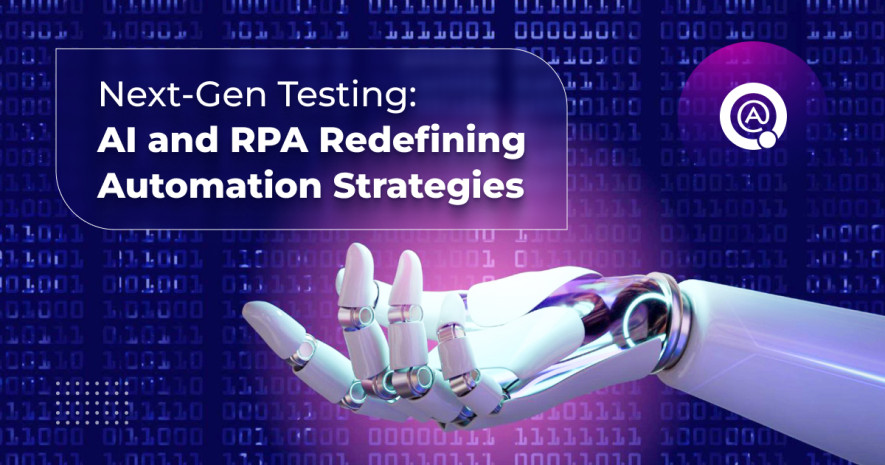- QATestLab Blog >
- Automated Testing >
- Next-Gen Testing: AI and RPA Redefining Automation Strategies
Next-Gen Testing: AI and RPA Redefining Automation Strategies

AI and RPA (Artificial Intelligence & Robotic Process Automation) have emerged as a cornerstone of operational efficiency in the contemporary business landscape. Many companies have embraced this technological revolution, recognizing its potential to perform tasks with unparalleled speed and accuracy. Businesses free up valuable resources by automating routine and repetitive tasks, allowing them to focus on innovation and growth.
However, the journey of automation does not end here. The next transformative phase involves the integration of AI. Adding AI into the automation mix elevates the entire process, introducing what is now called “hyperautomation.” Gartner, a leading research and advisory company, defines hyperautomation as “an unavoidable market state,” indicating its critical importance in the future of business operations. This fusion of AI with traditional automation techniques creates a synergy that is more than the sum of its parts. You can learn more about AI and Machine Learning (ML) in our latest article.
In this guide, we delve into the realm of AI in automation, mainly focusing on Robotic Process Automation (RPA) and other robotic tools in Quality Assurance (QA). The article’s goal is to provide a fundamental understanding of how AI can be utilized in automation efforts to achieve efficiency and develop it to a new echelon of effectiveness. The integration of AI in RPA and QA tools represents a significant leap towards sophisticated, intelligent automation – a leap that promises to redefine the boundaries of what automation can achieve in the business world.
AI and RPA in Test Automation: Understanding Their Distinctive Roles
AI in test automation significantly advances how testing is conducted in software development. At its core, AI is a facet of computer science focused on creating intelligent machines capable of performing tasks that typically require human intelligence. This includes learning from data, making decisions based on complex algorithms, and adapting to new inputs. When integrated into automation tools, AI transforms them from task executors into intelligent systems capable of learning, adapting, and making decisions, significantly enhancing their effectiveness and scope. This capability enables AI to handle dynamic and complex test environments, improving the efficiency and accuracy of testing processes.
RPA, while also a form of automation, serves a different purpose in test automation. RPA is primarily utilized for automating repetitive, rule-based tasks within the testing process. These tasks might include setting up test environments, managing data sets, or executing specific test cases that do not require deviation from a defined script. RPA is highly effective in reducing the manual effort involved in these routine aspects of testing, thereby increasing operational efficiency.
The key difference between AI and RPA in test automation lies in their operational capabilities and application scope. With its learning and decision-making abilities, AI is suited for tests requiring adaptability and complex decision-making. In contrast, RPA is ideal for repetitive, high-volume, rule-based tasks that do not require deviation. While AI brings intelligence and adaptability to test automation, RPA adds speed and efficiency in executing predefined tasks.
Combining AI and RPA in test automation leverages the strengths of both: AI’s intelligent analysis and adaptability and RPA’s efficiency in task execution. This synergy leads to a more robust and efficient testing process. However, it is essential to emphasize the importance of human oversight. Human expertise is crucial in designing and monitoring these automated processes, ensuring they align with the overall testing objectives and ethical standards. This human-AI-RPA collaboration ensures a more effective, accurate, and ethical approach to test automation.
Crafting the Ideal Strategy for RPA in Test Automation
Implementing Robotic Process Automation (RPA) in test automation marks a significant stride toward enhancing efficiency and precision in software testing. RPA’s ability to automate repetitive and structured tasks within test cycles offers immense potential to streamline testing processes. However, to harness this potential fully, a well-defined, strategic approach is essential. This approach must be tailored to fit the unique demands of test automation, aligning with the organization’s broader objectives while optimizing testing workflows. This segment will outline a structured, step-by-step strategy for effectively integrating RPA into test automation.
Step 1. Evaluate and select test cases for automation.
Begin by assessing the existing test cases to identify those most suitable for RPA. Ideal candidates are repetitive, data-intensive, and have a high degree of predictability. This selection process is crucial as it determines the efficiency gains that RPA can deliver.
Step 2. Define specific goals for RPA integration.
Clearly articulate what you aim to achieve with RPA in test automation. Objectives may include reducing the time for test execution, minimizing manual errors, or enhancing test coverage. Setting specific, measurable goals will guide the implementation process and help quantify success.
Step 3. Choose the appropriate RPA tools.
Select RPA tools that align well with your test automation environment. Consider factors like compatibility with existing test frameworks, ease of integration, scalability, and vendor support. The right tools should meet current needs and be adaptable to future requirements.
Step 4. Develop and train a skilled team.
Assemble a team skilled in both test automation and RPA. Provide training to ensure they are adept in using RPA tools and understanding their application in test automation. A knowledgeable team is fundamental to a successful implementation.
Step 5. Pilot setup and feedback.
Implement RPA in a controlled pilot phase. Start with a small set of test cases to monitor the effectiveness of RPA. Use feedback from this phase to fine-tune the process, address any challenges, and optimize the automation workflows.
Step 6. Full-scale implementation and continuous monitoring.
Following a successful pilot, expand the use of RPA across more test cases. Continuously monitor the performance and impact of RPA on test automation. Use metrics and feedback to make iterative improvements and ensure alignment with predefined goals.
Step 7. Ensure compliance and security protocols.
Integrate robust security measures and compliance checks within the RPA framework. Regularly update and review these protocols to safeguard sensitive data and maintain integrity throughout the test automation process.
Step 8. Ongoing support and evolution.
Establish a system for ongoing support, maintenance, and updates of RPA tools and processes. Stay abreast of advancements in RPA technology to refine and evolve the test automation strategy continually.

Successfully integrating RPA into test automation requires a strategic and methodical approach. By carefully selecting appropriate test cases, setting clear objectives, choosing the right tools, and building a competent team, organizations can lay a solid foundation for RPA in test automation. The pilot phase plays a critical role in understanding the practical implications and effectiveness of RPA, paving the way for a broader implementation.
Revolutionizing Software Testing With AI-Powered Testing Tools
AI-powered testing tools are a significant innovation in the field of software testing. They utilize artificial intelligence to enhance various aspects of the testing process, assisting QA teams in both traditional activities and more advanced cognitive tasks. These tools represent a step towards the highest level of the Autonomous Testing Benchmark, signifying a leap in testing automation and intelligence.
AI-enabled testing tools offer many advanced features that improve the entire Software Testing Life Cycle (STLC):
Test Script Generation. AI and ML technologies expedite test script creation by analyzing requirements, existing test cases, and application behaviors. They also provide templates and can generate scripts from plain language instructions.
Test Data Generation. AI tools can develop synthetic data, transform existing data for diverse scenarios, and refine data for accuracy while scanning large code bases for context.
Intelligent Test Execution. AI automates the organization and execution of test cases across various environments and selectively executes regression tests for critical features.
Smarter Test Maintenance. AI minimizes redundant testing and failures through self-healing mechanisms and analyzing UI and code changes.
Root Cause Analysis. AI aids in analyzing logs, performance metrics, and reports to trace issues back to their origins, leveraging knowledge bases for support.
RPA tools are like advanced macros that enable scheduled and batch execution of business applications and automate manual and clerical processes as needed. Here is a list of some of them:
- Katalon Platform. A comprehensive solution for testing web, API, desktop, and mobile applications. Features include TrueTest™ for user interaction modeling, StudioAssist for code generation from plain language, a GPT-powered manual test case generator, SmartWait for intelligent test execution pauses, self-healing mechanisms, visual testing, AI-powered test failure analysis, test flakiness assessment, image locator, and web service anomalies detection.
- TestCraft. This AI-powered tool based on Selenium is user-friendly and excels in constructing automated tests for web software. It offers parallel test execution across multiple browsers and environments and uses an ML algorithm for accurate web element identification.
- Applitools. Specializing in the visual aspect of app testing, it uses AI and ML for effective visual bug identification and offers comprehensive visual test analytics and reporting.
- Functionize. A cloud-based functional, performance, and load-testing tool, it employs AI and NLP for test creation and execution, offering self-healing capabilities and multiple browser support.
- Mabl. Ideal for low code testing, Mabl offers an intuitive GUI, automated healing, data-driven capabilities, comprehensive end-to-end testing, and insightful analytics.
- AccelQ. Automates test designs and plans for UI, mobile, API, and PC software testing, providing predictive analysis and comprehensive lifecycle test management.
- Testim. Utilizes machine learning for efficient test creation and maintenance, offering a smart locator method that enhances element identification and reduces maintenance efforts.

AI-powered testing tools are reshaping the landscape of software testing. They offer unprecedented efficiency, accuracy, and coverage by automating and enhancing various aspects of the testing process. These tools not only accelerate testing processes but also accommodate code changes better, improving overall software quality. As the field of AI in testing continues to evolve, these tools are set to become indispensable assets in QA teams, driving the future of software testing towards greater innovation and effectiveness.
Trust Your Software To Automated Testing with QATestLab
In recognizing the vital interplay of human intelligence and the advancements in AI and RPA, it becomes clear that the path to truly effective and efficient automated testing and quality assurance lies in this harmony. At QATestLab, we understand this delicate balance and have positioned ourselves at the forefront of this technological evolution. Our expertise in automated testing is not just about deploying the latest tools and technologies in AI and RPA. It’s about integrating these cutting-edge solutions with the invaluable insights and creativity that only human experts can provide.

We invite you to explore how QATestLab can elevate your automated testing processes. Our team of skilled professionals is equipped to handle all aspects of QA and test automation, ensuring that your business keeps pace with technological advancements and benefits from a comprehensive, human-centric approach to automation. Let us help you harness the full potential of AI and RPA, tailored to your unique business needs, ensuring that your automated testing strategies are not only technologically advanced but also strategically sound and ethically grounded.
Contact QATestLab today and take the first step towards transforming your QA and automated testing processes. Together, we can drive your business towards more sophisticated, efficient, and groundbreaking achievements in the world of automation.
Learn more from QATestLab
Related Posts:
- Automation Testing for Mobile Apps: Why It’s Essential and Our Key Services
- QA Automation Tools: Low-Code, No-Code, or Coding-Based?
- Warning Signs: How to Identify Inefficient Test Automation in Your Project
About Article Author
view more articles






